Built in the remote eleventh
century, the St. Sophia Cathedral in Kyiv never fails to evoke admiration
as an outstanding masterpiece of monumental art. Writer of Old Rus llarion
stated, "A church of wonder and glory, the envy of all the countries far
and wide." The cathedral was surrounded by churches dedicated to the patron
saints Ч St. Irene and St. George Ч and by the boyars palaces of stone
and the wooden dwellings of the ordinary townsmen. The cathedral retained
its pivotal role in the subsequent years: looted and dev-astated after
the raids of the steppe nomads in 1240, it was still the central church
in Kyiv: in the seventeenth century new structures of wood were erected
in the cathedral courtyard. In the eighteenth century, the cathedral was
surrounded by an ensemble of stone buildings, Baroque in style, which adorn
the city even today.
Many events in the political
and social life of Kyivan Rus were closely associated with the St. Sophia.
It was here that the ceremony of anointing and crowning the prince was
per-formed; here, he mounted the Grand Throne of Kyiv to receive foreign
ambassadors and to conclude trade agreements or peace treaties with other
principalities. The first mention of the library collected by Yaroslav
the Wise (the first in Old Rus so far as we know) is also associated with
the St. Sophia Monastery. Kyiv's veche (people's assembly) was held in
the Sophia's courtyard. During the centuries that followed, the cathedral
retained its role as the city's center. It was here that in January 1654,
Kyivites approved the historical decisions of the Pereyaslav Rada on the
reunification of the Ukraine with Russia.
The reconstruction work
carried out in the seventeenth Ч eighteenth centuries drastically altered
the original appearance of the monument. The architectural Baroque modifications
made in the later periods conceal the eleventh-century architectural elements
and structures. The essential interior dimensions of the structure (37
x 55 metres; the ceiling is 29 metres high) remain unchanged. Yet, the
compositional arrangement of architectural members has been altered. The
eastern facade boasted Five apses, the same as the number of aisles. There
were two rows of cloisters, the inner row had two stories, while the outer
one.' They skirted the building from the north, west and south. The cathedral
was crowned with thir-teen semispherical domes coated with sheet-lead.
Two asymmetrical stairway towers on the western front led to the choirlofts.
In the eastern part of the north gallery there was a chamber with a small
apse which served as a princely burial place. The stone sarcophaguses of
the Grand Princes of Kyiv once stood here, among them, those of Yaroslav
the Wise, Vsevolod Yaroslavich, Vladimir Monomachus and other political
figures of Old Rus.
The wall masonry showed
alternating layers of dark-red quarry-stone and plinthoi separated by a
thin layer of pink mortar made of whitewash and crusted brick. This made
the structure particularly attractive.
The interior design of the
cathedral has remained practically unaltered: the walls and twelve cruciform
piers which articulate the interior space into five aisles, the pillars
and the arches of the cloisters have remained. Thirteen cupolas with drums
have been fully preserved. The main drum is superimposed upon the intersection
of the nave and the transept and illuminates the space under the central
cupola.
In the eighteenth century,
the open two-storied cloisters were blocked up, while the single-storied
cloisters were given a second story and were crowned with domes. Window
openings were cut through the walls, and a large arch replaced the former
entrance. The western double-tiered triple-bayed arcading in the central
cupola space (similar to the surviving southern and northern ones) and
the choiriofts above it have not survived. That is why the space under
the central cupola which once had cruciform outlines, changed its shape
in its western part.
The St. Sophia Cathedral
possesses some 260 sq. m. of mosaics and 3,000 sq. m. of fresco painting
dating from the eleventh century. These examples of the ancient art of
our people are especially valuable. The mosaics and frescoes that survived
represent only one third of the murals which once adorned the cathedral.
In the seventeenth century, the missing portions of the St. Sophia murals
were filled with size-color paintings. At the turn of the eighteenth century,
the cathedral walls were plastered and whitewashed. Throughout the eighteenth
century, new paintings were done in oils upon the plaster cover. In the
nineteenth century, the fresco paintings were cleaned and later re-painted
in oils, the ancient drawings being preserved for the most part. The missing
fragments of the frescoes were replaced with plaster and painting.
As soon as the St. Sophia
Cathedral was declared a museum, vast restoration projects were undertaken
to clear the mosaics and frescoes of later plastering and overpainting.
The art of later periods was preserved only in those sections where the
ancient plaster had de-teriorated. So apart from the eleventh-century mosaics
and frescoes, there are individual works dating from the seventeenth and
eighteenth centuries as well as some from the nine-teenth. The subject
matter of the overwhelming majority of the paintings is based on re-ligious
themes. Our contemporaries praise their artistic qualities Ч line, color
scheme, composition and the skilful psychological renditions.
The harmonious unity of
mosaic and fresco compositions is a characteristic feature of mural ornamentation
in the St. Sophia Cathedral. The mosaics, distinguished for their bright
colors, decorate the central cupola and the central apse to draw the attention
of the visitor to the sanctuary section of the cathedral. The principle
characters of Christian teaching are represented in the St. Sophia mosaics:
at the top of the cupola there is a mosaic represen-tation of Christ Pantocrator
set in a medallion and surrounded by four figures of archan-gels, of whom
only one, arrayed in blue, remains as a mosaic. The other three were painted
by Vrubel in 1884. In the spaces between the drum windows the twelve apostles
are depicted (but only St. Paul has survived as a mosaic). The pendentives
are given to a view of the four evangelists, of which the image of St.
Mark has been more or less fully preserved. A scene of The Annunciation
decorates the piers before the chancel. The Archangel Gabriel is to the
left and the Virgin Mary, to the right. Over this composition are representations
of martyrs set in medallions. Over the central arch The Deesis mosaic composition
is represent-ed. A majestic six-metre-high image of the Virgin Orans, the
Madonna in prayer, is to be found in the vault of the chancel, the central
space of the apse shows a multifigured com-position of The Eucharist.
The mosaics in the upper row of the apse depict The Church Fathers Range.
The mosaics were made of
smalto Ч an alloy of glass, salts and oxidized metals: pieces of natural
stone were also used. To achieve the mosaic image, tesserae about one cu.
cm. in size were embedded in wet plaster. Specialists presume that eight
unknown master mosaicists executed the works. The mosaics in the cathedral
are remarkable for their rich and pure tones. The mosaic palette numbers
177 hues and shades. The gold background covers some one third of the mosaic
space, and the principle colors of the compositions are blue, off-white
and crimson. Every color has a number of shades: 19 are red: 21 dark-blue:
34 green; and 25 gold. The combination of large patches of color which
can be clearly seen from a distance (e.g., the blue array of the Virgin
Orans upon a background of gold, or the deep-purple table in the center
of The Eucharist and the off-white garments of the Apostles) is characteristic
of the St. Sophia mosaics. On the other hand, the mosaic compositions are
distinguished by subtle nuances of color which help convey facial features
or folds of garments. Illustrative of the above-mentioned fact is the representation
of the Archangel from The Annunciation scene. The mosaics in the chancel
and the main cupola are an in-dispensable part of the artistic unity of
both mosaics and frescoes.
Fresco paintings have been
more or less preserved in all of the chambers of the cathedral.
The space below the central
cupola is decorated with a cycle of scenes from the Gospel. The monumental
paintings in the Chapel of Joachim and Anna relate the story of the Virgin
Mary. The frescoes in the Chapel of SS. Peter and Paul tell of the acts
of the Apostle Peter. The mural paintings in the south chapel are devoted
to St. Michael, who was considered the patron of Kyiv and of the prince's
warriors. The frescoes in the northern chapel relate the life of St. George,
the patron saint of Yaroslav the Wise.
In the lofts, an entire
cycle of fresco paintings has survived. It includes scenes Abraham Meets
the Three Strangers, Abraham and the Angels, Abraham Offers Up Isaac, The
Three Youths in the Fiery Furnace, The Last Supper, and The Miracle at
Cana.
A place of importance in
the cathedral is taken by ornamental paintings: they frame window and door
openings, put emphasis on the curved lines of arches and vaults, adorn
the surfaces of columns and pillars and decorate panels above the floor.
The color palette of the
ancient frescoes was based on the combination of dark-red, yellow, olive
and white tones depicted against a blue background. The monumental painting
in the St. Sophia Cathedral is distinguished for clear-cut composition,
expressive images, and vivid colors. It also presents an organic unity
with the cathedral's architecture.
Thematically, the murals
of the St. Sophia were united by a single conception Ч the prop-agation
of Christian teaching and the consolidation of feudal power. Apart from
this, however, the paintings in the metropolitan's church were to reflect
the grandeur of Old Rus, its international authority, and the role of the
princely house of Kyiv in the political life of Europe. That was why a
great number of compositions were of a secular character. The three walls
of the nave opposite the chancel were covered with a group portrait of
the family of Yaroslav the Wise, founder of the cathedral. The central
place in the composition was taken by the image of Christ and the figures
of Princess Olga and Prince Vladimir. To the left and to the right there
is Yaroslav, his wife Princess Irene, and their sons and daughters. The
procession is headed by Yaroslav the Wise who holds a model of the St.
Sophia Cathedral in his hand. In this mural, Yaroslav the Wise is represented
as the builder of the city and founder of the metropolitan's church, drawing
on the traditions established by his great grandmother Princess Olga and
his father Prince Vladimir who greatly con-tributed to the unification
of the Slavic tribes, to the consolidation of the Kyivan Rus state, and
to the establishment of equitable relations with Byzantium and other countries.
The members of Yaroslav's family played a role of importance in European
political life: the wife of Yaroslav the Wise was a daughter of the Swedish
King, two of Yaroslav's sons married Byzantine princesses, and his daughters
were queens of France, Norway, and Hungary. According to llarion, eminent
writer of the time, "The land of Rus was known to the four quarters of
the globe." Unfortunately, only the figures of Yaroslav's children on the
south and partially on the north wall have survived into our time of what
was once a splendid mural composition. The missing parts can be reconstructed
according to a draw-ing of the Dutch painter Abraham van Westerfeldt who
saw the fresco in the mid-seven-teenth century.
Specialists, among them
S. Vysotsky, Dr. Sc. (History), proved that the fresco paintings in the
cathedral's towers were devoted to an important political and cultural
event of the tenth century Ч the visit of Kyivan Princess Olga to the Byzantine
capital, and the honors paid to her by Byzantine Emperor Constantine Porphyrogenitus.
In the northern as well
as the southern tower, the murals should be viewed from below as one mounts
the stairs to the lofts. The frescoes in the northern tower depict the
ceremony of Princess Olga's entry into Constantinople. Only fragments representing
the Empress with her retinue and the Emperor Roman, the son of Constantine
Porphyrogenitus, riding a white horse have come down to us. In the upper
landing of the stairway one can see Constantine Porphyrogenitus Receives
Princess Olga, a large composition that has been fully preserved. The left
part of the composition is occupied by the image of the Emperor on his
throne surrounded by two body-guards armed with spears and shields. The
figure of Prin-cess Olga occupies the right section of the composition.
Her headgear consists of a crown and a transparent white kerchief falling
onto her shoulders. Beside her are depicted the women from her retinue.
The focal point of the southern
tower is The Hippodrome mural painting. The scene shows the second reception
of Kyivan Princess by the Byzantine Emperor at the hippodrome in Constantinople,
where Princess Olga was invited to see the chariot races. In the upper
section of the tower, there is a well preserved representation of the hippodrome
premises Ч a large three-storied building, the open galleries of which
are intended for spectators. In the right part of the composition we see
Constantine Porphyrogenitus himself. In this portrait, the artist has successfully
conveyed the facial features of the Emperor Ч expressive eyes, a large
aquiline nose and a beard. Princess Olga is depicted arrayed in light beside
him. Most likely the other frescoes in the tower are also associated with
specta-cles at the hippodrome. Among them are The Acrobats group painting
and The Buffoons composition which shows musicians playing string, percussion
and wind instruments, including a pipe organ.
The walls in the towers
are adorned with various ornaments, symbolic drawings and hunting scenes:
Bear Hunt, Fighting Mummers, Wild Boar Hunt, etc. These scenes shed light
on various aspects of court life, hunting, and the flora and fauna of Old
Rus. The fresco painting in the cathedral towers presents unique samples
of monumental art and is an important source of information on the historical
and cultural ties of Old Rus and Byzantium.
Interesting murals have
been preserved in the former baptistery of the St. Sophia Cathedral. They
include an eleventh - century fresco composition The Forty Martyrs of Sebaste.
This chamber was made a baptistery at the turn of the twelfth century,
when an apse was at-tached to the arch of the cloister. The frescoes preserved
in this apse Ч Baptism and the Fig-ures of the Church Fathers Ч are illustrative
of the stylistic peculiarities of monumental art of the period.
The ornamental slate slabs
making parapets of the lofts as well as the sarcophagus of carved marble
where Yaroslav the Wise was interred in 1054 are unique monuments of Old
Rus art. A great role in the interior decor of the cathedral was played
by the floors: the central part was of mosaic, while the floors in the
aisles, on the lofts and in the burial chamber were of ceramic tiles with
a colored slip-glaze finish. A part of the ancient floors has survived
into modern times,
Medieval inscriptions (graffiti)
have been preserved in many places on the walls of the cathedral. Of special
importance are those which provide us with facts about political and cultural
life in Kyivan Rus. The Old Slavic alphabet has survived among the graffiti
on the walls of the St. Sophia Cathedral. It has shed light on the formation
of the Cyrillic alphabet. Among works of art dating from the eighteenth
century is the gilded iconostasis carved of wood, the gilt copper doors
in the narthex, and the fragments of wall painting. Of special interest
to visitors are valuable examples of monumental art of the early twelfth
century Ч mosaics, frescoes and slate relief panel from St. Michael's Cathedral
of the Golden Domes Ч which are put on display in the second floor chambers
of the cathedral. Comparing the St. Sophia murals with those of St. Michael's,
one can trace stylistic changes which had taken place in the monumental
art of Old Rus by the twelfth century. In St. Michael's Cathedral murals,
the figures are more animated, the postures are varied, and the propor-tions
are more elongated. The mosaic tesserae are larger than in the St. Sophia
Cathedral, and dominant tones in the mosaic compositions are green in combination
with violet, pink and off-white. The murals in St. Michael's Cathedral
stress line. This is especially true of the artists' treatment of the Figures'
garments. Presumably, eminent artist of Old Rus Alipiy of the Kyiv-Pechersk
Lavra participated in the painting of murals in St. Michael's Cathedral.
Today the St. Sophia Cathedral is surrounded by former monastery buildings
which repre-sent valuable examples of eighteenth century Ukrainian architecture.
The whole ensemble is dominated by a 76-metre-high Bell Tower richly embellished
with stuccowork. It lends an inimitable charm to the city's skyline.
South of the cathedral buildings
are the premises of the Refectory, which in the nineteenth century was
rebuilt into a heated church Ч the Little Sophia. The unique outline and
ex-pressive form of the building are characteristic of Ukrainian Baroque
structures. The Metropolitan's Residence, a two-storey monumental structure
with a Baroque-style pediment, also underwent reconstruction throughout
its existence. Yet, it has retained its eighteenth-century form in general.
The building is located opposite the main entrance of the St. Sophia cathedral.
It is ranked high among other monuments of eighteenth-century Ukrainian
architecture.
In the first half of the
eighteenth century, the Bakery was built in the south-west section of the
cathedral grounds; in the nineteenth century it was made into a Consistory.
The research carried out on the building has helped us discover its initial
form. By the Consistory is located the southern two-tiered entrance tower
which was erected in the mid-eighteenth century. In the nineteenth century
a part of archives documents from the Consistory was kept here. The tower
is crowned with a hemispherical cupola which terminates in a spire.
North of the St. Sophia
Cathedral is the Church Seminary built in 1763Ч1767. Of interest are the
window surrounds and the stucco moulding on the upper part of the pilasters.
These features were definitely borrowed from eighteenth-century Russian
architecture. The building which housed the cells of the cathedral elders
is located to the northwest o' the cathedral. It was erected in the 1750s.
The building has been altered considerably over the years. In 1970 it was
restored, and the ground-floor chambers were returned to their initial
eighteenth-century arrangement and appearance. Austere forms and a wooden
cloister (reminiscent of buildings constructed in the folk style) lend
this structure a unique appearance.
Approaching the Cathedral
from the direction of Streletsky Lane, one can see a section c' the monastery
wall erected in 1745Ч1746 that has survived into our times. In the eighteenth
century, such a wall encircled the entire monastery. The western part of
the wall incorporates the Zaborovsky Gate, a marvellous structure typical
of Ukrainian Baroque. The Gate was erected by architect J.-G. Schadel in
1746. It served as a formal entrance from the west into the metropolitan's
courtyard. Profuse stucco molding covering the surfaces of the pediment
and the Gate's arch testifies to the fact that folk master-craftsmen took
part in the enterprise.
The St. Sophia Cathedral
and the surrounding eighteenth-century architectural monuments are of great
interest to visitors to the Kyiv. |

St. Sophia Cathedral
old photo

The Refectory
XVIII cent
Western facade

Metropoliten's
Residence.
XVIII cent.
Eastern facade

View of the chancel

Interior
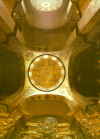
View of the
central cupola
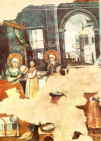
"The nativity of the
Virgin"
Early XVIII cent.
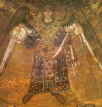
The central cupola
Archangel
XI cent. mosaic

Iconostasis.
XVIII cent
Detail

"The Miracle at
Coniah"
XVIII cent.
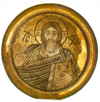
The central cupola
Chist Pantocrator
XI cent. mosaic

Sarcophagus of
Princess Olga from
the Church of the
Tithes

12h-century mosaic
from St. Michael's
Cathedral of the
Golden Domes.
St. Thaddeus

Apses of the
St. Sophia Cathedra

"Eucharist"
Left part

"Eucharist"
Right part

Choirlofts. "Abraham
Ofers Up Isaac"

Choirlofts. South-
west cupola.
Archangel

Sarcophagus of
Yaroslav the Wise
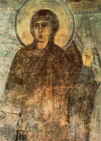
"The Annunciation"
The Virgin Mary
XI cent fresco
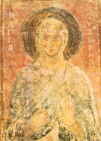
Western inner
cloister. St. Eudoxia
XI cent fresco

South inner cloister.
St. Thocus
XI cent fresco

12th-century fresco
from St. Michael's
Cathedral of the
Golden Domes.
St. Zachariah

"The Annunciation".
The Virgin Mary
|